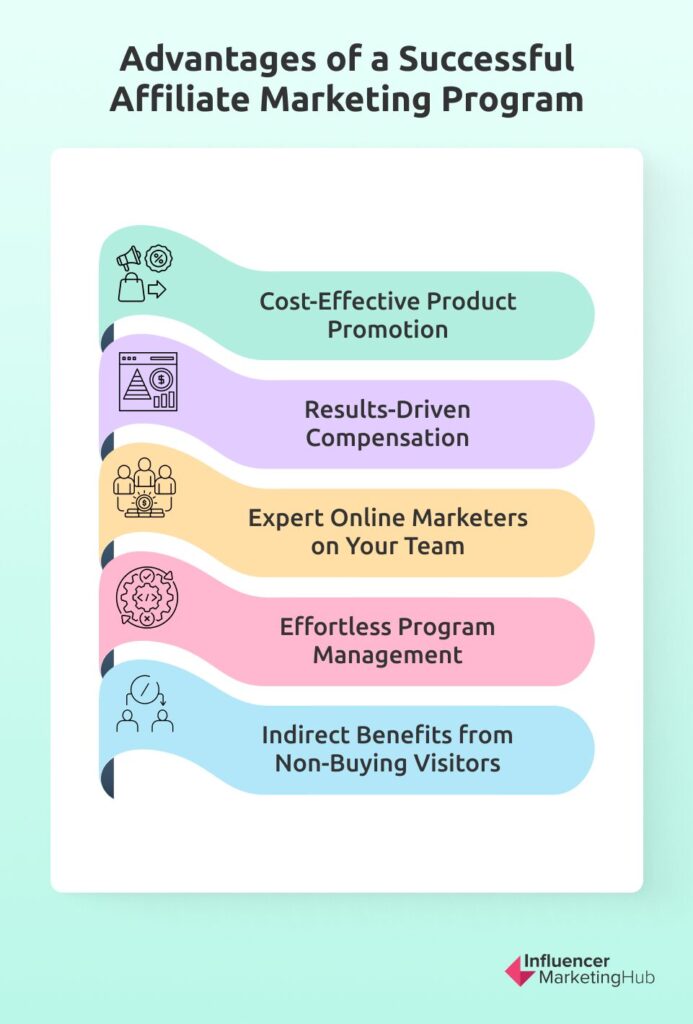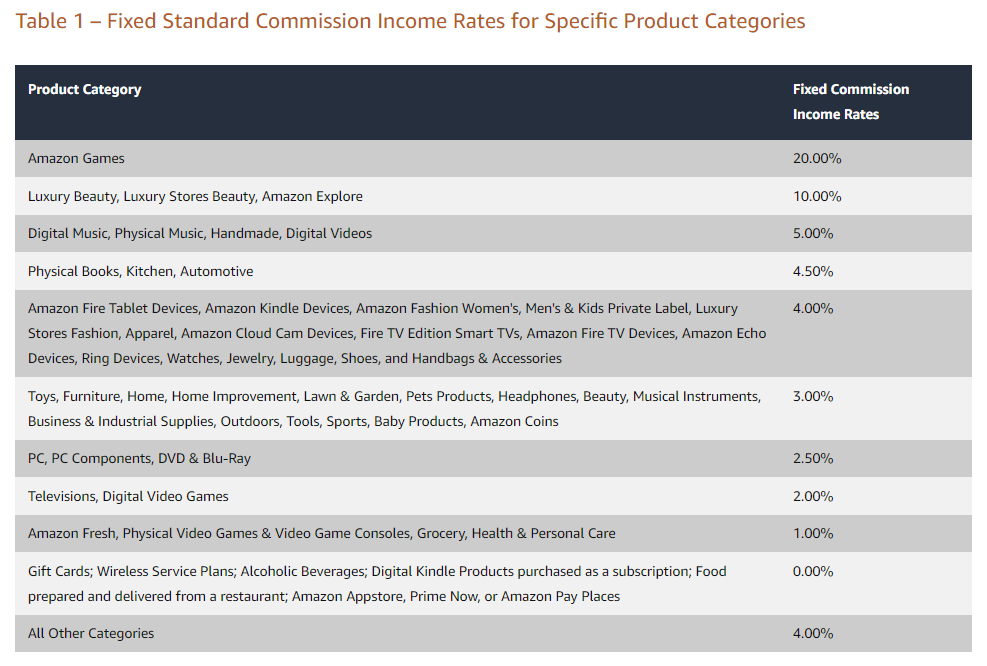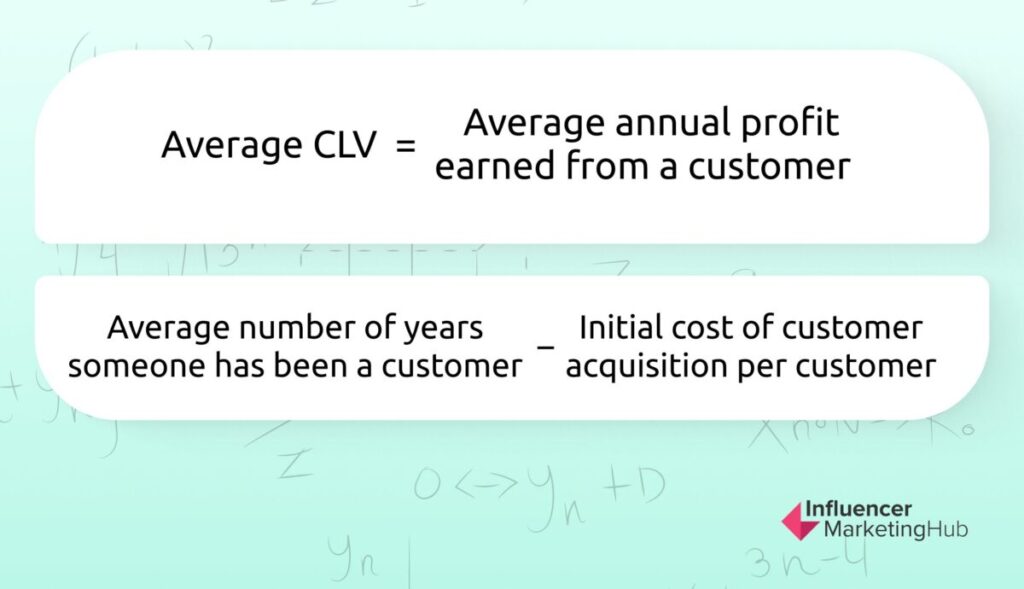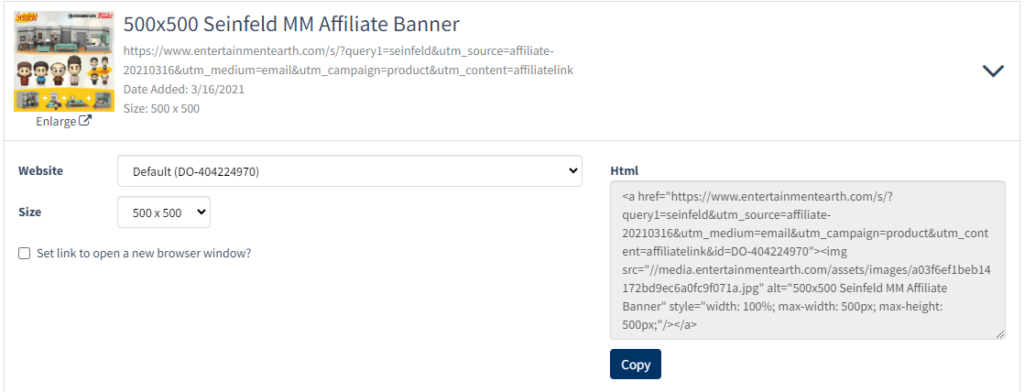Not everybody’s a born marketer and salesperson. You might love creating products, collating products, or even just coming up with new and innovative products, but the actual nuts and bolts of marketing and selling these products may not be for you. It may look like time-consuming hard work, and you may feel you have better and more lucrative things to do. If that’s you, don’t worry. You have plenty of options to ensure somebody else does marketing and sales. One possibility is to set up a (hopefully) successful affiliate marketing program, and through that acquire a team of eager promoters and marketers of your products.
In this post, we examine the steps you need to go through to create a successful marketing program.
How to Create a Successful Affiliate Marketing Program:
Who Are the Main Parties Involved in Affiliate Marketing?
As we saw in our The Complete Guide to Affiliate Marketing, there are three (sometimes four) parties involved in the process:

- The Product Creator/Merchant– you, i.e., whoever provides the products or services for sale.
- The Affiliate Network – (optional) Some product creators use an intermediary rather than creating their own affiliate marketing program.
- The Affiliate Marketer – these people market selected products and encourage their supporters to buy them. They can be businesses, influencers, bloggers, vloggers, or website owners, happy to promote your products in return for commission.
- The Consumers – the people who take notice of recommendations made by the affiliate marketers, and ultimately buy the products.
If you’re trying to create a successful affiliate marketing program, you are the product creator/merchant/seller, and you won’t use someone else’s affiliate network to connect you to affiliate marketers. Instead, you will want to deal with them directly.
Explanation of the Rise of Affiliate Marketing in the Digital Age
Although you can use affiliate marketing as a means to sell virtually anything, it is particularly useful for eCommerce businesses, selling items online. By using customized links, sellers can send leads to the product creator/merchant, who can easily keep track of which affiliates generate sales.
Many affiliate marketing tools and platforms provide in-depth analytics, making it easy to see which affiliates are most successful at finding buyers for your products. They can also offer an online repository of content and graphics that affiliates can use in their marketing.
Affiliate marketing is particularly valuable for mobile marketing, with more than 50% of all web visits now made on mobile devices. In recognition of this, many affiliate marketers target their promotions primarily at mobile users and optimize their content for mobile screens.
Initially, eCommerce was slow to take off, with people naturally being skeptical about their money being safe online. However, before long, there were sufficient online security protections and Trust measures to encourage vast numbers of people to shop online. The affiliate marketing industry incorporated many safeguards, and consumers became willing to spend their money online, even at “no name” affiliate stores and via social commerce.
Affiliate marketing has become particularly popular for SaSS products, where dedicated affiliate marketers can encourage their supporters and followers to buy subscriptions, with repeating monthly payments.
Affiliate marketing has evolved with technology, featuring solutions for tracking, reporting, and verifying the authenticity of transactions.
Benefits of an Affiliate Marketing Program
There are many advantages to product creators/merchants if they can create a successful affiliate marketing program. These include:

- You can market new, unknown products, for little cost, effort, and time, once you’ve set up your program. It is up to individual affiliates to decide how many resources they should devote to promoting your products
- You only pay for results. If affiliates don’t send purchasers to your landing page, who in turn purchase your products, you don’t have to pay any commission to them. You don’t need to pay in advance for advertising or other marketing costs.
- If you pay a competitive commission to your affiliates, which still leaves you in a profitable position, then you should have some expert online marketers working as part of your affiliate team. Potentially these marketers may be far better at their job than any workers you could employ in-house as salespeople.
- Once you’ve set up your affiliate marketing program, you can “set and forget” it, occasionally adding new products or adding new content and marketing material to assist your affiliates.
- You can even benefit indirectly from non-buying visitors sent through affiliate links. They might not buy your goods now, but you are at least building goodwill and name recognition for possible future purchases.
Overview of the Steps to Create a Successful Affiliate Marketing Program
Every business is different, and the exact sequence of steps you will go through should reflect the particular characteristics your company faces. For example, if you sell one or two main products, then you will probably already know what you intend potential affiliates to market, meaning that you won’t have to worry about Stage Three of our process. Similarly, if you’ve been involved with affiliate marketing in the past, you might already know the software/platform you want to use. Be prepared to adapt this process to best meet the needs of your organization.
1. Set Goals for Your Affiliate Marketing Program
One thing we regularly emphasize in our articles is the importance of setting goals. There has to be reasons why you are doing anything in your business. Goals give you long-term vision and short-term motivation. They help you organize your time and resources and not get bogged down with unimportant nice-to-haves.
There is little point in setting up an affiliate marketing program just for the sake of it, or because you read somewhere that it could be a good idea.
As with all your marketing activities and channels, you will need to consider the types of people you hope will purchase the products your affiliates market. You are going to need to target affiliates who can reach the “right” types of people. There is little point of devoting your time and energy to working with affiliates with the “wrong” audiences.
For example, HubSpot operates an affiliate program that encourages its affiliates to promote its CRM platform. HubSpot. It states that the program is best for “content creators who share content about marketing, sales, service, website, and operations for small businesses, enterprises, and individual professionals.”
You will want to set some SMART goals for your affiliate program, i.e. your goals should be specific, measurable, attainable, relevant, and time-bound. Consider setting goals relating to the amount of revenue your affiliates can generate per month (or other period of your choice), conversion rates, and other relevant factors.
2. Analyze Your Competitors’ Programs
It is highly possible that your competitors already operate affiliate programs. If so, it makes sense to analyze their programs, determining their strengths and weaknesses. This knowledge can very much save you from repeating their mistakes. Ideally you should look at least two programs that target the same type of audience as yourself, even if they sell a different product type. For example, if you operate email marketing software, you would obviously take an interest in the affiliate marketing programs of direct competitors GetResponse and ConvertKit. However, you might also consider analyzing the affiliate program of the landing page platform, Unbounce, too, as they are also ultimately targeting small businesses wanting to improve their online marketing success. Both types of business will want marketers, agencies, and bloggers sharing content about marketing as affiliates.
You will want to look at factors such as:
- How each program structures their affiliate commissions
- How they pay successful affiliates
- How they go about recruiting affiliates
- How strict their requirements are for affiliate acceptance
- Any restrictions they place on affiliate activities
- Types of affiliate links they give affiliates. Do they use affiliate tracking cookies, and if so, how do they work?
- Any promotional and branding resources they provide
Ultimately, you will want to determine the strengths and weaknesses of each of your competitors’ programs, so you can take on their best points, while improving on their worst factors.
3. Determine the Products to Include in Your Affiliate Marketing Program
Some affiliate marketing programs focus solely on selling a single flagship product. Others, however, offer an entire catalog of products, and affiliates can pick and choose to promote a selection of products from the catalog that best suits them.
Many different types of businesses at different stages of the production cycle choose to use affiliate marketing to promote their products. These include manufacturers, wholesalers, and retailers who opt to use affiliate marketing. They include small online creators of a single product, as well as colossal retailers like Amazon who have created the world’s largest affiliate marketing program to promote the myriad of products they sell.
However, regardless of your size, it makes sense to start with a few products in your affiliate program and then add to your catalog once the originals are bedded down and you know that everything’s working as it should.
Once your affiliate program is settled and fully operational you can spend some time optimizing to ensure that everything’s running as efficiently as possible. Then you could consider additional products to the scheme.
4. Decide the Offer You’ll Make to Your Affiliates
Affiliates need an incentive to join your affiliate marketing program. While Amazon Associates can get away with paying affiliates below-average rates, a new unknown scheme certainly can’t.

Source: affiliate-program.amazon.com
Commission rates are generally set as a percentage of each sale you make, although some affiliate programs prefer to pay flat-rate commissions. High commission rates will attract more affiliates wanting to sell your products, but if you set them too high, these products no longer remain profitable for your company. Remember that affiliate marketing is performance-based, however; you only have to pay money to affiliates who make sales.
Depending on your niche, the average affiliate marketing commission rate sits in the range of 5-30%.
Referral Rock suggests you should calculate your average customer lifetime value (CLV) as a guide.

Average CLV = Average annual profit earned from a customer * Average number of years someone has been a customer – Initial cost of customer acquisition per customer
To calculate this, you ask yourself three questions:
- How much does it usually cost to bring in a new customer?
- What percentage of customers do you retain in a given year?
- How much revenue can you rely on each customer to bring in?
It may be tricky to calculate your CLV if you’re a new business, however.
Your average affiliate commission must be well below your average CLV to be sustainable.
If your competitors offer affiliate programs for similar products to yours, take a look at the affiliate commissions they offer. You will need to ensure that your offer is competitive with theirs.
You need to determine rates that are both enticing compared to competitors and affordable for your business, starting with a base rate near the lower end of that range. This gives you “wriggle room” to increase your rates later if necessary.
You could also consider offering commission bonuses to your highest-performing affiliates. For example, you could offer them to affiliates who meet certain lifetime revenue goals. Streak bonuses encourage high performers to meet a given amount of monthly or quarterly sales to unlock a limited-time commission rate boost or qualify for a meaningful gift.
Some affiliate programs use a tiered commission system where those affiliates who unlock a certain level of lifetime sales become eligible for higher commission levels permanently.
If your affiliates sell subscriptions, you can set an affiliate commission scheme, offering recurring commissions whenever a customer renews their subscription.
You will have hopefully examined the commission rates offered by your main competitors. You will need to match or better these rates if you hope to attract the best affiliates in your niche. The rates will differ markedly between industries, however.
For example, marketing tool suite Semrush offers its affiliates:
- $200 for every new subscription
- $10 for every new lead
- $0.01 for each new signup
Web hoster, Hostinger, offers a flat commission rate of 60% for every referred sale.
The previously mentioned HubSpot pays affiliates a rate depending on the plan customers choose (and lets them stack up commissions when customers buy more than one product. For example HubSpot plans are for a range of products (including Sales and Marketing), and each plan comes at one of three levels. They pay affiliates based on these levels:
- Starter/Basic: $250
- Professional/CMS: $500
- Enterprise: $1,000
If a customer signs up to the Marketing Starter and Sales Professional at the same time, for example, the referring affiliate would earn $250 + $500.
5. Decide How You Want to Set up Your Affiliate Program
You will need to spend some time planning how you want your affiliate program to look. You will need to consider what expectations you will have for your affiliates. Will you accept any applicant for your program, will you set minimum requirements for affiliates (for example requiring them to have an existing blog site or social audience of a certain size), or will you limit your affiliates to a select few?
You might want to place limitations on how affiliates promote your products, particularly if you’ve already cultivated a particular brand and look. You don’t want them to tarnish the look or image of your brand, producing marketing that is very dissimilar to your other campaigns.
In addition, you will need to think about how you are going to determine when a particular affiliate is responsible for a sale. For example, if a customer uses an affiliate link to come to your eCommerce store, but then buys a different product, can that affiliate claim the sale and receive the commission?
You will need to draft an affiliate program policy and set rules for your affiliates. They are ultimately representing your brand. Be particularly clear about what you require from affiliates for them to qualify for payment of commissions. Your affiliate marketing software may have templates to walk you through this process.
6. Decide on the Affiliate Marketing Tools/Platform You Will Use
While you could manage your affiliate marketing program in an Excel spreadsheet and a few other simple tools at a push, that doesn’t give you much chance to scale. You will find it much easier to use specialist affiliate marketing software to ensure you cover all the necessary tasks.
We have reviewed many affiliate marketing software products. These help automate tasks relating to automated recruiting, affiliate management, referrals, advanced analytics, integrated payments, product/gifting tools, affiliate campaigns, and more. Some platforms, like Refersion and Upfluence, recognize the affinity between affiliate marketing and influencer marketing and assist with both. Another combination software is UpPromote, which is an affiliate/referral marketing app for Shopify eCommerce stores.
One of Refersion's standout features is its ability to connect affiliates with brands sharing similar target audiences. They effectively provide matchmaking services between brands and content creators. It didn’t take long for Refersion to notice the similarities in this basic premise with the way influencer marketing operates, so they expanded their offering to include influencer marketing as well as affiliate marketing. Refersion has apps that integrate with Shopify, BigCommerce, WooCommerce, Magenta, Stripe, and Chargebee - and if you don’t use one of these platforms for your eCommerce site, you can integrate using Refersion’s API. Refersion includes a marketplace where you can make an Offer with specifics about what you need and what you are willing to pay, and wait for people to apply to participate. Alternatively, you can use the platform to look for partners based on your mutual target audience.
Trackdesk is a comparatively new affiliate marketing tool that focuses on generating and distributing referral codes and links. It's intuitive to use, featuring a user-friendly interface that avoids including unnecessary bloatware. It handles multiple locations, languages, and currencies. You can use it to create multiple offers, each with its own localization setting, targeting affiliates in different countries, and its own landing page. You can use Trackdesk to store creatives for your Offers, which the affiliates can use to aid in their efforts.
PayKickstart acts as both a shopping cart and an affiliate marketing platform, not to mention a payment gateway, a service for managing/charging for memberships and subscriptions, and even a landing page builder. It offers affiliate marketing programs many of the services they need to support their businesses. It includes affiliate recruiting, and management. You can use it to create a stockpile of marketing resources that your affiliates can access.
While you will have to pay to use these affiliate marketing tools, they will save you a considerable sum in the long term. And most (of not all) of these tools cost less than paying to be a member of an existing affiliate marketing network.
7. Recruit Affiliate Marketers
You’re going to need to work to find suitable affiliates to market and sell your products. Indeed, for your affiliate marketing program to be successful, you will need to market it, using many of the same techniques your affiliate marketers will use to sell your products.
Some affiliate marketing programs set strict requirements for who they will accept as an affiliate - only content creators with the “right” audience, as we described in our Goals section, should apply. Other programs are more lenient on who they accept, willing to work with virtually anybody who meets relatively minimal “entry requirements”. Many of the larger, more generic programs, such as Amazon Associates, set relatively limited restrictions, reflecting the size and variety of their target customer base.
The most common areas to focus on when screening potential affiliates include:
- social media reach (and the types of accounts following the applicant)
- types of content the applicant makes (and where they share it)
- existing eCommerce stores/websites of the applicant.
You will need some form of website/platform that your affiliates can use as a base for their dealings with you. Depending on the tools you’ve chosen, you may have already set this up. If you haven’t already done so, ensure that you have a landing page to send potential new affiliates, using all the SEO techniques you use for any other website to ensure online visibility.
You can begin recruiting potential affiliate marketers by promoting your affiliate program through your social accounts, in much the same way you promote your products. Likewise, if you currently engage in email marketing, consider adding promotions for your affiliate program there.
You may already have an idea of potential affiliates with whom you’d like to work. In that case, conduct outreach to make contact with them. Remember, however, that your affiliate program will need to be attractive to them. Hopefully, thanks to the research you’ve carried out, you’re offering a competitive deal to them, with sufficiently high commission rates, fair attribution models, long cookie duration and promised fast payments times.
You could search for affiliates by Googling suitable keywords, relevant to your business. This may bring up content creators (even influencers) who could be worth considering, in addition to those you already know. Similarly, you may find people worth approaching in online groups and forums. Don’t forget relevant LinkedIn and Facebook Groups in your niche. Take time to build relationships with potential affiliates before you approach them.
As we’ve previously mentioned, many of the affiliate marketing tools provide platforms where you can make offers to potential affiliates.
You will need to screen applicants who apply to be members of your program. Examine their content (social media, blogs, vlogs, eCommerce stores etc) to see how good a fit they are for your brand. Look at the engagement on this content. Check their online activities to ensure that they haven’t engaged in unethical activity (that would conflict with the ethos of your brand).
No matter what method you use to find your affiliates, you will need a system in place to keep track of affiliate referrals. Again, affiliate marketing tools and platforms can enable this, ensuring that your affiliates can feel confident that you recognize the work they do to market your products.
8. Train Your Affiliates
Ideally you should provide some training for new affiliates, so they understand your expectations and know the dos and don’ts of marketing your products. Ideally set up a section of your website with training materials that your affiliates can return to every time they need assistance.
Affiliate marketing relationships are typically long-term, rather than campaign-by-campaign, so you can’t expect them to sign them off on a one-off training program. You will want to constantly build your relationship with them, and ideally should have somebody available to run the program. Send out regular communications, for example creating an affiliate newsletter and offering them new deals and promotions. You could schedule regular webinars for your affiliate team, and create an exclusive group for them on Slack, Facebook, or LinkedIn.
9. Support Your Affiliates
Although most product creators/merchants (i.e., operators of affiliate marketing programs) give their affiliates a fairly free rein to sell their products, they do typically create resources to make things easier for them.
They usually create customized links for each affiliate, making it easy to determine who has sent a potential customer to the sales website. Alongside this, many affiliate marketing programs offer marketing graphics and other materials that their affiliates can use. For example, Entertainment Earth provides affiliates with a range of banners they can use in their marketing.

When you select one of these banners, affiliates can view a link to the image that they can use on their websites or elsewhere in marketing.

Ideally, you should create your graphics in various sizes, catering to different marketing channels your affiliates may use. This means that they can be used on your affiliates’ websites, their social messages, or even in their email marketing.
Some of your affiliates may be bloggers. You can create graphics these bloggers can use in ads on their blogs. In addition, they can create posts highlighting features of your products, and they can incorporate your graphics into their articles. Another advantage of encouraging these types of blog posts is that your bloggers can include suitable keywords in their articles as SEO to make your product more visible to Google.
10. Keep Track of Your Affiliates’ Progress
At the beginning of this process of setting up an affiliate program we referred to setting goals. There is little value in goal-setting, however, if you don’t make any effort to see how you're progressing towards meeting these goals. And it’s particularly important with an affiliate program, because you pay your affiliates based on their performance.
Tracking helps you establish the worth of each affiliate, ensuring that you receive value for money and can devote your time and resources to your best performers.
Affiliate tracking typically captures customer page views, clicks, and conversion data that your affiliates can provide you. You can use affiliate marketing software to process this data and generate reports showing the effectiveness of your program.
Traditionally your affiliates used cookies that software software placed in users’ devices whenever somebody followed a link from one of their content pieces to a website. Whenever somebody returned to that website, the cookie recognized it, and provided data to interested parties. That way you could easily keep track of which affiliate sent a potential customer to your online store (and who deserved the commission payment of the customer subsequently spent money there). Unfortunatel;y cookies aren’t foolproof - they didn’t necessarily mirror real-life and consumers are inherently suspicious of being tracked. In addition, the European Union’s General Data Protection Regulation (GDPR) allowed people to opt out of receiving cookies, and then Google and Apple placed restrictions on cookie use.
Traditionally, brands have used pixel tracking. Here a snippet of code on a specific web page (often a confirmation or “thank you” page, sent information to a brand when an affiliate customer reached the page.
Nowadays brands tend to use postback URL tracking, that doesn’t rely on creating cookies. Instead it uses an invisible URL to pass on conversion data to the brand. This is more complicated than pixel tracking, so you will definitely need to use specialized affiliate software to engage in this. Unlike pixel tracking, postback tracking functions with both mobile apps and eCommerce sites.
Wrapping Things Up
You can sell virtually anything using affiliate marketing. By doing so, you are effectively outsourcing the marketing of your products. However, it is particularly suitable for SASS-based services and items you sell online.
Perhaps the two most important requirements are that you make it easy for affiliates to join your affiliate marketing program, and you then make things easy for them to promote your products.
Unless you are a name brand, with product evangelists happy to promote your products simply because they love them, most affiliates will be participating because they want to earn money. Therefore, you have to make things easy for them to encourage them and avoid placing impediments in their way.


